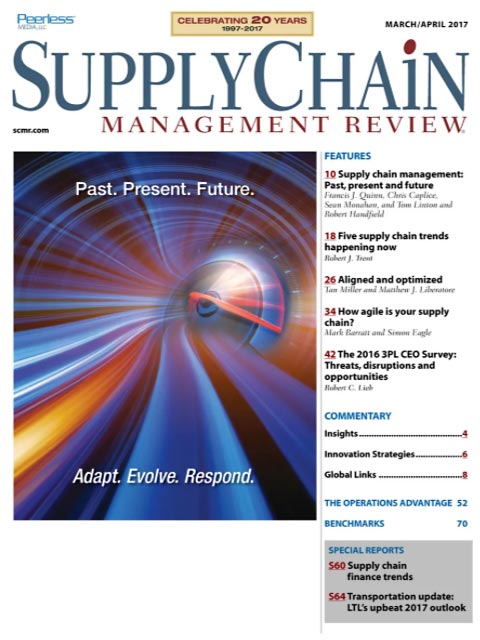Sorry, but your login has failed. Please recheck your login information and resubmit. If your subscription has expired, renew here.
March-April 2017
Supply Chain Management Review, which is celebrating its 20th anniversary with this issue.Twenty years after the premier issue, our goal remains the same: To present thought leadership around best practices in supply chain fundamentals, publish case study examples of what leading companies are doing in their supply chains and keep our finger on the pulse of emerging trends and technologies that will shape the future. While Frank’s essay looks to the past and brings us to the present, we also have essays from four experienced supply chain professionals looking to the future of supply chain management. Browse this issue archive.Need Help? Contact customer service 847-559-7581 More options
There’s a new supply chain game in town. The rules of this new game are not widely understood, but the purpose couldn’t be clearer: America first. President Trump has vowed to put the interests of America and the American worker “first” in fashioning his trade and foreign policy.
For seven decades, both Republican and Democratic administrations embraced the notion that an internationalist foreign policy and a global trade strategy would create domestic prosperity and bind nations together in global harmony. Today, critics of this “old game” say our current pro-trade foreign policy has caused irreparable harm to America’s economic interests, and, in particular, to American workers and the domestic economy. American jobs have disappeared and plants have either moved abroad or closed due to foreign imports. Manufacturing jobs between 1990 and 2015 dropped from 18 million to 12 million. There is no question that manufacturing efficiency and automation played a large role in these trends, but the political reality of lost jobs and decimated towns across America has subordinated global trade to the needs of the American worker. The new administration in its first trade manifesto states, “it will take a zero-sum approach—with every negotiation starting from the basis of how American workers will be helped.”
Learning the new rules
All companies are now faced with a new playing field, new players and few guidelines. Historical precedents are not readily available for what appears to be a massive reversal of global trade policy. With most medium and large companies operating on a global scale, the first question on everyone’s mind is what is the best manufacturing and supply chain strategy given the shifting winds of potential new government policies; particularly, those around trade and regulations. Should we proceed or hold on off-shoring plans? Should we move to quickly re-shore manufacturing activity? Will there be levies on our global suppliers, or tariffs on goods made in offshore facilities, and how will that affect our competitiveness?

This complete article is available to subscribers only.
Log in now for full access or start your PLUS+ subscription for instant access.
SC
MR
Sorry, but your login has failed. Please recheck your login information and resubmit. If your subscription has expired, renew here.
March-April 2017
Supply Chain Management Review, which is celebrating its 20th anniversary with this issue.Twenty years after the premier issue, our goal remains the same: To present thought leadership around best practices in supply… Browse this issue archive. Access your online digital edition. Download a PDF file of the March-April 2017 issue.There's a new supply chain game in town. The rules of this new game are not widely understood, but the purpose couldn't be clearer: America first. President Trump has vowed to put the interests of America and the American worker “first” in fashioning his trade and foreign policy.
For seven decades, both Republican and Democratic administrations embraced the notion that an internationalist foreign policy and a global trade strategy would create domestic prosperity and bind nations together in global harmony. Today, critics of this “old game” say our current pro-trade foreign policy has caused irreparable harm to America's economic interests, and, in particular, to American workers and the domestic economy. American jobs have disappeared and plants have either moved abroad or closed due to foreign imports. Manufacturing jobs between 1990 and 2015 dropped from 18 million to 12 million. There is no question that manufacturing efficiency and automation played a large role in these trends, but the political reality of lost jobs and decimated towns across America has subordinated global trade to the needs of the American worker. The new administration in its first trade manifesto states, “it will take a zero-sum approach—with every negotiation starting from the basis of how American workers will be helped.”
Learning the new rules
All companies are now faced with a new playing field, new players and few guidelines. Historical precedents are not readily available for what appears to be a massive reversal of global trade policy. With most medium and large companies operating on a global scale, the first question on everyone's mind is what is the best manufacturing and supply chain strategy given the shifting winds of potential new government policies; particularly, those around trade and regulations. Should we proceed or hold on off-shoring plans? Should we move to quickly re-shore manufacturing activity? Will there be levies on our global suppliers, or tariffs on goods made in offshore facilities, and how will that affect our competitiveness?
SC
MR


Latest Supply Chain News
- Israel, Ukraine aid package to increase pressure on aerospace and defense supply chains
- How CPG brands can deliver on supplier diversity promises
- How S&OP provides the answer to in-demand products
- AI, virtual reality is bringing experiential learning into the modern age
- Humanoid robots’ place in an intralogistics smart robot strategy
- More News
Latest Podcast

 Explore
Explore
Topics
Latest Supply Chain News
- Israel, Ukraine aid package to increase pressure on aerospace and defense supply chains
- How CPG brands can deliver on supplier diversity promises
- How S&OP provides the answer to in-demand products
- AI, virtual reality is bringing experiential learning into the modern age
- Humanoid robots’ place in an intralogistics smart robot strategy
- Tips for CIOs to overcome technology talent acquisition troubles
- More latest news
Latest Resources

Subscribe

Supply Chain Management Review delivers the best industry content.

Editors’ Picks





